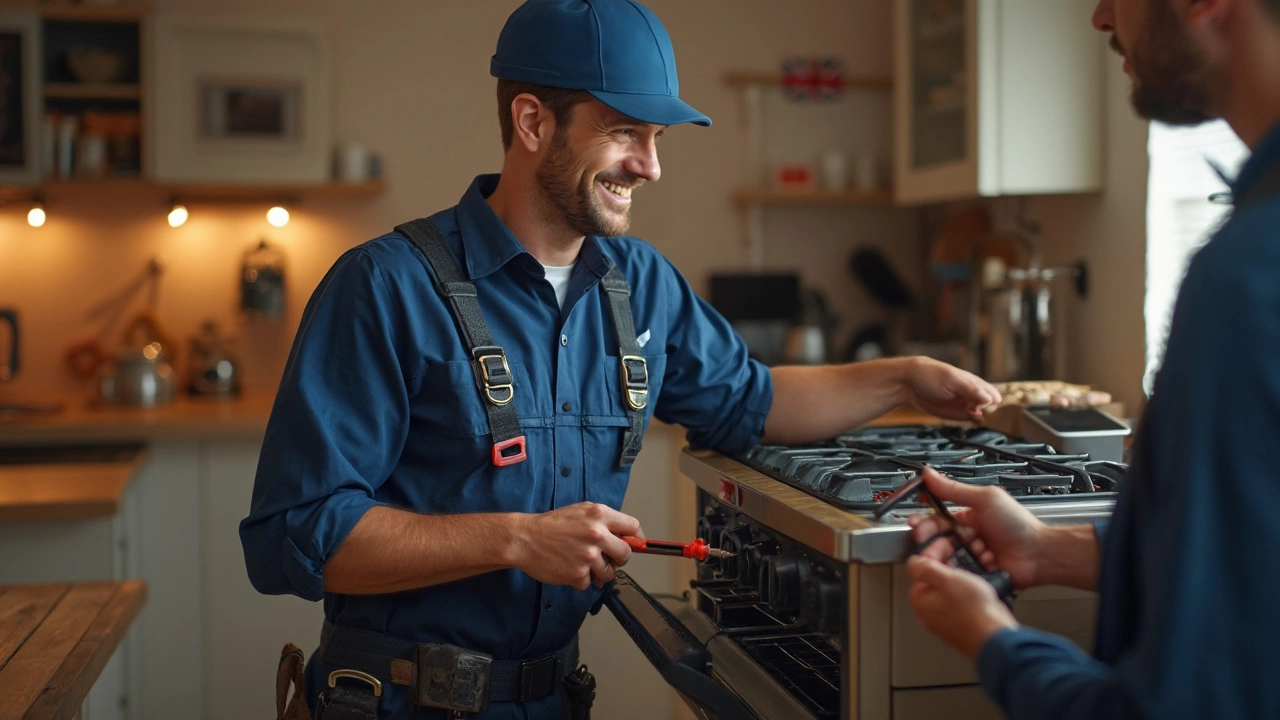
- 19 Apr 2025
- Gideon Thornton
- 0
Picture this: you’re about to bake your favorite lasagna, and your 8 year old oven suddenly won’t heat up. It’s a hassle, and now you’re stuck with a big question—should you spend money fixing it or just buy a new one?
The cost of a basic oven repair can run anywhere from $100 for a simple heating element switch to $400 or more if the control board’s fried. Parts for older models are usually still around, but some brands start phasing them out after 7-10 years. If your oven’s been working okay until now, don’t let the age alone push you into feeling it’s beyond hope.
Here’s a tip: check for obvious signs like weird noises, uneven cooking, or error codes on the display. If smoke or sparks showed up, unplug it and call a pro. The most common fixes at this age are heating elements, thermostats, and door gaskets, which are usually cheaper than buying new. If you start stacking up repairs every few months though, your oven might be telling you it’s ready for retirement.
- How Long Do Electric Ovens Really Last?
- Typical Repairs and Costs after 8 Years
- When to Repair vs Replace: The Real Break Point
- Tips to Get More Life Out of Your Oven
How Long Do Electric Ovens Really Last?
When people say an oven "lasts forever," they're exaggerating. On average, a electric oven covers about 13 to 15 years before it starts really acting up. That means your 8 year old oven is probably only halfway through its life, if you’ve treated it decently and done the usual cleaning and maintenance.
What makes the biggest difference in lifespan? It’s a mix of build quality, how much you use it, and whether you’ve kept up with simple stuff like cleaning out old food bits or checking the door seal. Cheap ovens or ones that get hammered every night tend to call it quits sooner than the higher-end models. Big family that bakes a lot? Expect things to wear down a bit sooner.
Here’s some data that might help you see where your oven stands:
| Oven Age (Years) | Chance of Major Repair Needed | Average Efficiency (%) |
|---|---|---|
| 5 | 15% | 98 |
| 8 | 28% | 95 |
| 12 | 50% | 91 |
A big thing folks forget—minor problems, like a burnt-out heating coil, are normal after a decade. That doesn’t mean the whole appliance is toast. But if you notice a long trend of things going wrong or the oven is struggling with basic tasks, then you’re headed toward that typical upper lifespan.
If your oven’s still baking evenly and doesn’t take forever to heat up, you’re usually good for a few more years. Keep an eye out for little issues—it’s way cheaper to fix them early than wait for something big to break down.
Typical Repairs and Costs after 8 Years
By the time your oven hits the 8 year mark, a handful of things are almost guaranteed to wear out. The most common electric oven repair jobs at this age involve heating elements, thermostats, door gaskets, and the occasional control board or sensor failure. If you hear your oven clicking, see inconsistent temperatures, or your food’s burnt on one side, these are the parts likely causing trouble.
For heating elements, which do most of the heavy lifting, replacement usually runs between $100 and $250—the part itself is cheaper, but labor adds up. Thermostats and temperature sensors can fail after years of baked-on grime and heat cycles. Swapping one out often costs $150 to $300, including the visit from a professional. If your oven’s digital controls go haywire, expect repairs closer to $300 or more. Some display boards, especially for older models, can set you back even more if the parts are tough to find.
Door gaskets might not seem important, but when they crack or stop sealing, you’ll lose heat and drive up your electric bill. Replacing a gasket could be as little as $75 if you do it yourself, or up to $150 if you get someone else to handle it.
Here’s a snapshot of typical repair costs for an 8 year old oven:
| Repair | Typical Cost Range (USD) |
|---|---|
| Heating Element Replacement | $100 - $250 |
| Thermostat / Sensor | $150 - $300 |
| Control Board / Display | $250 - $400+ |
| Door Gasket | $75 - $150 |
| General Diagnostic Fee | $70 - $120 |
Always check if your model still has parts available. Some brands phase out inventory once an oven gets past 8 to 10 years. If a tech tells you a part is “obsolete” or only found online for big bucks, factor that into your repair-vs-replace thinking.
Bottom line: One-off repair costs for most electric ovens aren’t crazy, but if you’re facing two or more pricey fixes in the same year, it might be time to think seriously about moving on to a newer model. Every situation is different, but these numbers should give you a realistic ballpark so you don’t get surprised by the bill.

When to Repair vs Replace: The Real Break Point
So, when does it make sense to fork out cash for electric oven repair and when is it smarter to get a new one? The real answer comes down to numbers—how much you'll spend now versus the value and headaches down the line.
Here's the usual line the pros use: if your oven repair costs more than half the price of a new oven, replacement is usually the better call. For example, if a decent new electric oven runs around $600, and repairs will cost $350, it’s probably time to move on. Prices do swing depending on your location and the oven brand, so check what a new model goes for in your area first.
Here's a quick way to break it down:
- If your oven needs a single, simple fix (heating element, thermostat, or door gasket), and it hasn’t had issues before, repair makes sense.
- If you’ve already sunk several hundred bucks into repairs in the past year, or you’re seeing constant quirks like weird smells, uneven cooking, or you can’t get parts easily—it’s time to shop around.
- If the oven is energy-guzzling or missing newer safety features, replacement can lower your electric bills and give peace of mind.
There are also hidden perks with upgrades. Newer ovens (since 2022) come with smart features and better insulation, which can shave about 10-15% off your energy usage compared to an old model. Sometimes, local utility companies offer rebates for switching to more energy-efficient appliances, so check to see if you can save a few bucks on the swap.
| Repair | Replace |
|---|---|
| Simple fix under $300 | Multiple repairs, costs add up |
| Parts still easy to find | Parts no longer available |
| Cooking evenly, no other problems | Uneven cooking, error codes, old controls |
| Less than 10 years old | Near or over 10 years old |
Bottom line: treat your oven like you do an old car. If it runs well and just needs a tune-up, fixing is fine. If it breaks down all the time, it’ll drive you crazy (and cost more in the long run). Use the numbers and your sanity as your guide.
Tips to Get More Life Out of Your Oven
Want to squeeze extra years from your 8 year old oven? It’s totally doable if you’re willing to give it a bit of TLC. Most oven problems come from dirt, worn-out seals, or ignoring warning signs. Here's what actually helps your electric oven last longer and work better while saving you hassle and money.
- Clean regularly: Grease builds up and can mess with the heating elements. Take out racks and scrub them. Wipe down the inside every couple of weeks, and avoid letting spills bake on. Don’t forget that crumb tray if your model has one.
- Check door seals annually: The oven door gasket is what keeps the heat inside. If it’s cracked, torn, or falling off, replace it. Even minor damage means the oven works harder (and uses more energy).
- Don’t ignore odd sounds or smells: Clicking, popping, or even a burnt plastic smell can signal a failing element or wiring issue. Catching this stuff early is way cheaper than waiting for a total breakdown.
- Use the self-clean only when needed: The self-clean mode gets super hot and can wear down parts faster if you use it every month. Stick to once or twice a year unless you’re a baking maniac.
- Calibrate the thermostat: If you notice your oven burning cookies or roasting unevenly, check if the temperature is accurate. You can use an oven thermometer for this. Adjusting the thermostat can make a big difference in cooking AND energy use.
Here’s a quick glance at some helpful maintenance moves—backed up by appliance techs who see these issues all the time:
| Maintenance Task | Recommended Frequency |
|---|---|
| Clean inside & racks | Every 2-4 weeks |
| Check & replace door gasket | Once a year |
| Test oven temp with thermometer | Twice a year |
| Look for signs of damage or weird sounds | Every use (just pay attention!) |
And here’s something a lot of people forget: power surges. If your area gets lightning or has old wiring, plug your electric oven into a surge protector if it’s allowed by the manufacturer. This helps prevent sudden electronic failures, which are usually some of the most expensive repairs.
Keep up with these small steps, and your oven could stick around another three to five years—with lower risk of sudden breakdowns and less wasted energy along the way.




